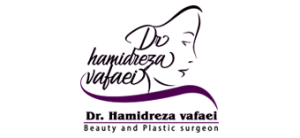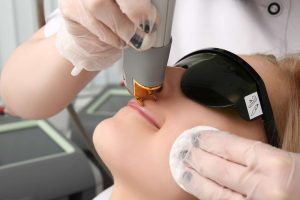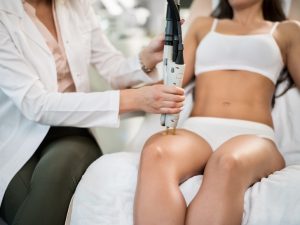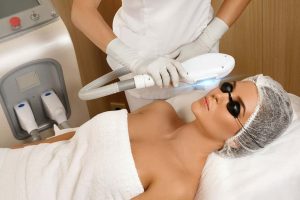Laser treatment
Laser is a treatment to reduce facial wrinkles and skin irregularities, such as blemishes or acne scars. The technique directs short, concentrated pulsating beams of light at irregular skin, precisely removing skin layer by layer. This popular procedure is also called lasabrasion, laser peel, or laser vaporization.
How can laser treatment help with scars?
Laser treatment penetrates the outer layers of skin to stimulate new, healthy skin cell growth. The laser removes older, damaged layers of skin so that new, healthy skin can grow in its place. Laser treatments are, in essence, creating a new scar in place of an old one. However, the new skin should grow more uniformly. The formation of scar tissue is a natural bodily response to injury. Scars are not harmful and do not require removal for medical reasons. However, if they are painful, limiting, or affect a person psychologically, a range of methods can reduce their appearance and discomfort.
Laser treatment can help with scars by:
- decreasing pain or itchiness
- reducing their appearance
- improving the range of motion of the skin around the scar
Doctors can choose from a variety of lasers that use different wavelengths of light and affect the skin in various ways. Some lasers are ablative, meaning that they remove the top layer of skin, while others are nonablative, retaining the skin’s surface while affecting the layers underneath. Some lasers may be unsuitable for certain skin tones because they may cause the skin to grow back discolored.
Examples of laser types that doctors use in scar treatment include:
- ablative fractional carbon dioxide laser
- intense pulsed light
- long-pulsed 1064-nm Nd:YAG
- nonablative fractional laser
- pulsed dye laser
- Q-switched Nd:YAG
A doctor should thoroughly evaluate a scar before recommending a laser for treatment use. They should explain the potential benefits unique to a particular laser as well as its possible side effects.
How to prepare
Doctors may recommend taking certain actions ahead of the procedure to ensure that it is as effective and safe as possible. These may include:
- Avoiding medicines and herbs that increase the risk of bleeding. Examples include aspirin, nonsteroidal anti-inflammatory drugs such as ibuprofen and naproxen, and herbal supplements such as garlic or ginkgo Biloba. It is important to tell the doctor about any prescription blood thinners.
- Avoiding products that contain glycolic acid or a retinoid for 2-4 weeks.
- Staying out of the sun and not exposing the skin to ultraviolet (UV) light for extended periods. Doctors may not be able to use laser therapy if a person has a tan or sunburn.
- Refraining from cosmetic procedures, such as chemical peels, collagen injections, and waxing.
- Quitting smoking at least 2 weeks before the procedure. Smoking impairs the skin’s ability to heal, which can affect the treatment results.
On the day of the procedure, the individual should avoid using lotions, deodorants, perfumes, or any other products that could potentially interact with the laser treatment. The skin should also be clean. According to the part of the body that requires treatment, a doctor will usually suggest wearing clothing that is easy to take off and put on, such as a soft button-up shirt and loose-fitting pants.
Procedure
Before a person undergoes laser treatment, a doctor will examine the scar and mark the skin with a pen to identify the area for treatment.
The following is an example of how the treatment process may work:
- A doctor will clean the area around the scar and may inject local anesthetic or apply a numbing cream to the area.
- If the scar is on the face, they may ask the person to wear protective goggles.
- The doctor will place wet towels or gauze around the scarred area to absorb laser pulses that would otherwise affect healthy skin.
- The doctor will pass the laser over the scar tissue. They may occasionally apply a cooling saline or water solution.
- After the treatment is complete, the doctor will apply an ointment and a clean dressing to cover the area.
The treated area may remain red for several hours after the procedure. There may also be mild swelling and stinging that might feel similar to a sunburn.
After the procedure, doctors often recommend applying moisturizing lotion to the area at least twice daily and refraining from applying makeup until the redness has gone away.
Which types of scar can it help with?
Laser treatment can help with many common types of scar, including acne scars and injury scars.
Doctors tend to recommend it for superficial scars. Deep scars or scars that restrict a person’s movement will typically respond better to more intensive treatment.
A doctor may recommend laser treatment for the following types of scar:
- acne scars
- burn scars
- surgical scars
- injury scars
you need to know it that laser treatment is not a cure for scars and does not remove them completely. In some cases, a doctor may recommend a combination of therapies, for example, using injectable fillers alongside laser therapy to make the scar less noticeable.
Are there any risks?
A doctor should discuss potential side effects and risks with the individual before performing laser procedures. The side effects may depend on the type of laser, the severity of the scar, and the person’s skin tone.
Some of the more common side effects include:
- minor bleeding
- discomfort
- skin infection
- skin crusting
- skin discoloration
- swelling
It is also possible that the laser scar treatment could prove ineffective or worsen the scar’s appearance.
How much do laser treatments cost?
Since laser treatments for scars are cosmetic and elective procedures, your insurance may not cover the cost.
The cost of treatment depends on:
- the size of the scar
- the number of scars
- the amount of laser treatments you’ll need
Keep in mind that you may need more than one laser treatment to get your desired results. You’ll have to pay each time you see your doctor for treatment. Because the out-of-pocket cost for laser treatment varies, it’s important that you consult with more than one doctor to compare prices before proceeding. Some offices will charge a consultation fee in addition to what you pay for the actual procedure. There’s no extended downtime with this treatment, so you don’t have to worry about too much time off work. You may be able to return to work the next day or within a few days.
Procedures for laser treatments for scars
During your consultation, your doctor will decide the best procedure for improving a scar. Your options may include the following:
Ablative or laser resurfacing
This type of treatment improves the appearance of scars, warts, and wrinkles. Resurfacing removes the outer layer of skin and eliminates skin cells that have been damaged at the surface level. Your doctor may use a carbon dioxide (CO2) laser for deeper scars, or an erbium laser for surface scars.
Fractionated laser resurfacing
A laser penetrates a deeper layer of the skin’s surface to remove dark pigmented cells. This procedure also stimulates collagen production and skin cell renewal, which can make your scars appear less noticeable.
Non-ablative laser resurfacing
Infrared heat lasers penetrate the inner layer of the skin. This also stimulates collagen production and cell renewal to replace damaged skin cells.
Laser treatments for scars are outpatient procedures, although the length of procedures vary. You can expect some mild discomfort during treatment. Your doctor will apply a topical anesthetic to numb the area so you don’t feel pain. You can ask for sedation if you’re treating a larger scar.









Leave a Reply
Want to join the discussion?Feel free to contribute!